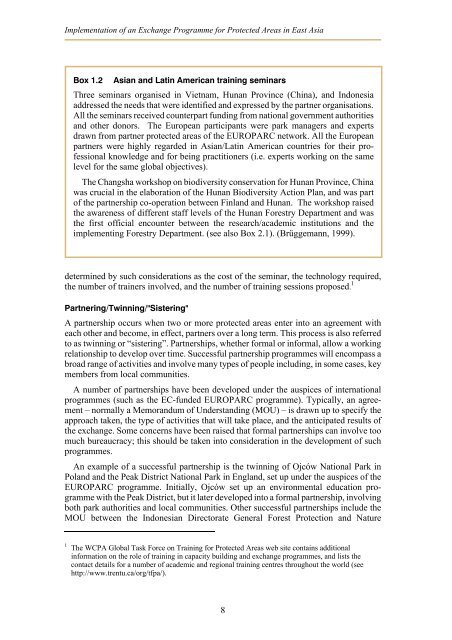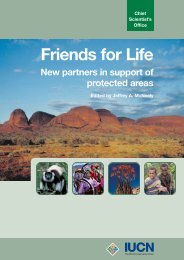Exchange programmes - IUCN
Exchange programmes - IUCN
Exchange programmes - IUCN
Create successful ePaper yourself
Turn your PDF publications into a flip-book with our unique Google optimized e-Paper software.
Implementation of an <strong>Exchange</strong> Programme for Protected Areas in East Asia<br />
Box 1.2 Asian and Latin American training seminars<br />
Three seminars organised in Vietnam, Hunan Province (China), and Indonesia<br />
addressed the needs that were identified and expressed by the partner organisations.<br />
All the seminars received counterpart funding from national government authorities<br />
and other donors. The European participants were park managers and experts<br />
drawn from partner protected areas of the EUROPARC network. All the European<br />
partners were highly regarded in Asian/Latin American countries for their professional<br />
knowledge and for being practitioners (i.e. experts working on the same<br />
level for the same global objectives).<br />
The Changsha workshop on biodiversity conservation for Hunan Province, China<br />
was crucial in the elaboration of the Hunan Biodiversity Action Plan, and was part<br />
of the partnership co-operation between Finland and Hunan. The workshop raised<br />
the awareness of different staff levels of the Hunan Forestry Department and was<br />
the first official encounter between the research/academic institutions and the<br />
implementing Forestry Department. (see also Box2.1). (Brüggemann, 1999).<br />
determined by such considerations as the cost of the seminar, the technology required,<br />
the number of trainers involved, and the number of training sessions proposed. 1<br />
Partnering/Twinning/"Sistering"<br />
A partnership occurs when two or more protected areas enter into an agreement with<br />
each other and become, in effect, partners over a long term. This process is also referred<br />
to as twinning or “sistering”. Partnerships, whether formal or informal, allow a working<br />
relationship to develop over time. Successful partnership <strong>programmes</strong> will encompass a<br />
broad range of activities and involve many types of people including, in some cases, key<br />
members from local communities.<br />
A number of partnerships have been developed under the auspices of international<br />
<strong>programmes</strong> (such as the EC-funded EUROPARC programme). Typically, an agreement<br />
– normally a Memorandum of Understanding (MOU) – is drawn up to specify the<br />
approach taken, the type of activities that will take place, and the anticipated results of<br />
the exchange. Some concerns have been raised that formal partnerships can involve too<br />
much bureaucracy; this should be taken into consideration in the development of such<br />
<strong>programmes</strong>.<br />
An example of a successful partnership is the twinning of Ojców National Park in<br />
Poland and the Peak District National Park in England, set up under the auspices of the<br />
EUROPARC programme. Initially, Ojców set up an environmental education programme<br />
with the Peak District, but it later developed into a formal partnership, involving<br />
both park authorities and local communities. Other successful partnerships include the<br />
MOU between the Indonesian Directorate General Forest Protection and Nature<br />
1 The WCPA Global Task Force on Training for Protected Areas web site contains additional<br />
information on the role of training in capacity building and exchange <strong>programmes</strong>, and lists the<br />
contact details for a number of academic and regional training centres throughout the world (see<br />
http://www.trentu.ca/org/tfpa/).<br />
8






